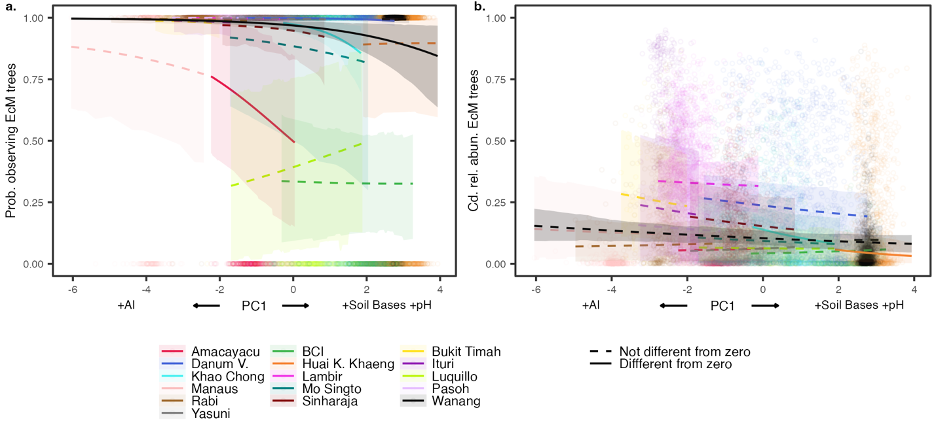The distribution and abundance of ectomycorrhizal trees in lowland tropical forests are independent of soil fertility.

The association between the probability of observing EcM trees and their relative abundance in relation to soil fertility across and within 16 lowland tropical forests. a,b, The black lines indicate the mean quadrat-level (20 × 20 m) predictions for the probability (prob.) of observing EcM trees (a) and their conditional relative abundance (cd. rel. abun.) in basal area across sites (b). Coloured dots indicate observations, varying by site, whereas the coloured lines show site-level mean predictions. Shaded areas around the mean lines show the 95% credible intervals of these predictions. Colours represent 16 sites from the lowland tropical regions of Africa (Ituri and Rabi), the neotropics (Amacayacu, BCI, Luquillo, Manaus and Yasuni), Oceania (Wanang), and Asia. Dashed lines indicate that the predicted slopes are not different from zero. PC1 is positively correlated with soil nutrient availability. Note that while panel a shows an association between soil fertility and the probability of observing EcM trees, predictions indicate that the probability of observing EcM trees consistently exceeds 0.75. Image courtesy of the authors.
The Science
This study investigates the distribution of mycorrhizae, plant-fungal partnerships that influence ecosystem function. Traditionally, it was believed that climate and decomposition rates determined mycorrhizal distribution, with arbuscular mycorrhizal plants being more prevalent in fertile areas and ectomycorrhizal plants in less fertile ones. However, using fine-scale data from lowland tropical forests, the study challenges this notion, revealing that soil fertility is not associated with the distribution of ectomycorrhizal-associated trees. The research underscores the importance of understanding mycorrhizal symbiosis in lowland tropics, refuting assumptions based on temperate and boreal regions, and highlighting historical biogeographies that influence mycorrhizal patterns in tropical forests worldwide.
The Impact
This study challenges our understanding of how plants and fungi collaborate in lowland tropical forests. It reveals that these relationships are more intricate than previously believed, and conventional ideas about nutrient levels and plant partnerships may not always hold true. The study stresses the importance of gaining a deeper understanding of the symbiotic relationships between plants and fungi in tropical regions, cautioning against assuming they operate similarly to other areas, like temperate and boreal regions. Overall, the research makes us rethink how plants and fungi interact in diverse tropical forests, highlighting the need for more studies to understand these complex partnerships.
Summary
Mycorrhizae, a form of plant-fungal symbioses, mediate vegetation impacts on ecosystem functioning. Climatic effects on decomposition and soil quality are suggested to drive mycorrhizal distributions, with arbuscular mycorrhizal plants prevailing in low-latitude/high-soil-quality areas and ectomycorrhizal (EcM) plants in high-latitude/low-soil-quality areas. However, these generalizations, based on coarse-resolution data, obscure finer-scale variations and result in high uncertainties in the predicted distributions of mycorrhizal types and their drivers. Using data from 31 lowland tropical forests, both at a coarse-scale (mean-plot-level data) and fine-scale (20 × 20 metres from a subset of 16 sites), we demonstrate that the distribution and abundance of EcM-associated trees are independent of soil quality. Resource exchange differences among mycorrhizal partners, stemming from diverse evolutionary origins of mycorrhizal fungi, may decouple soil fertility from the advantage provided by mycorrhizal associations. Additionally, distinct historical biogeographies and diversification patterns have led to differences in forest composition and nutrient-acquisition strategies across three major tropical regions. Notably, Africa and Asia’s lowland tropical forests have abundant EcM trees, whereas they are relatively scarce in lowland neotropical forests. A greater understanding of the functional biology of mycorrhizal symbiosis is required, especially in the lowland tropics, to overcome biases from assuming similarity to temperate and boreal regions.
Contact
José A. Medina-Vega
Forest Global Earth Observatory, Smithsonian Tropical Research Institute, Washington, DC, USA
jamedinavega@gmail.com
Funding
This research and J.A.M.-V. were supported as part of the Next Generation Ecosystem Experiments-Tropics, funded by the US Department of Energy, Office of Science, Office of Biological and Environmental Research. Funding for data management, quality control, travel, and consumables was provided by various funding agencies to the principal investigators of the plots used in this study. For detailed information on site-specific funding, please refer to the supporting documents of the manuscript.
Publications
Medina-Vega, JA., Zuleta, D., Aguilar, S. et al. “Tropical tree ectomycorrhiza are distributed independently of soil nutrients”. Nat Ecol Evol (2024). https://doi.org/10.1038/s41559-023-02298-0